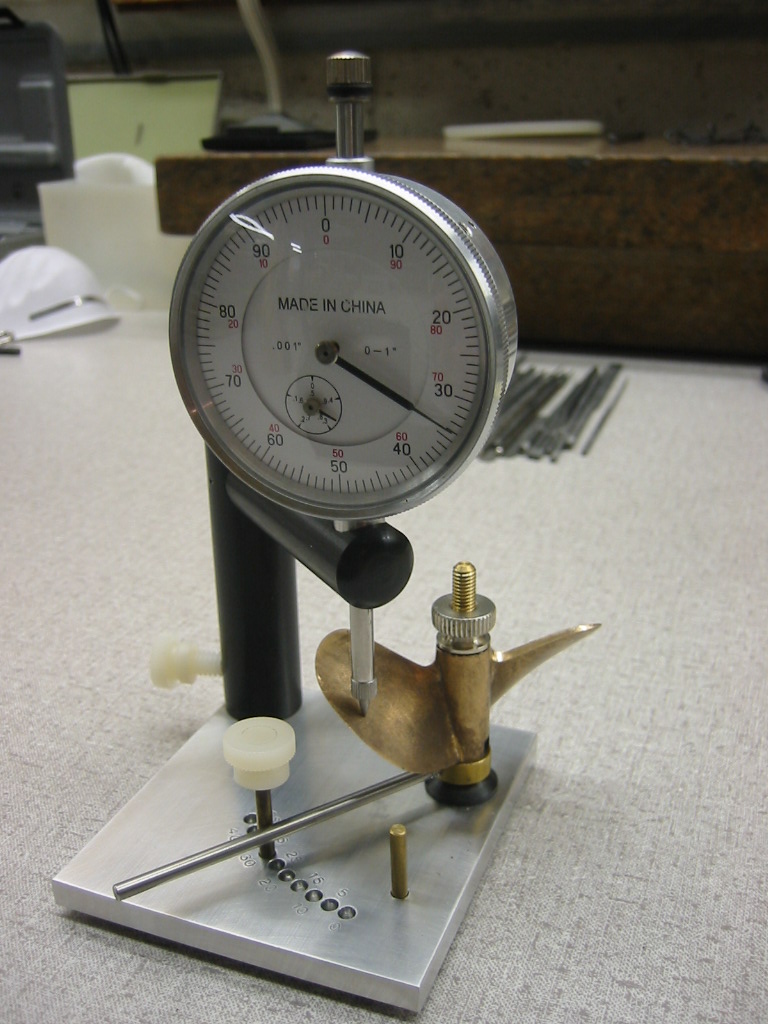Ian,
On this 2260, I just measured the center 20% of the blade and took the sweep at about 60% out. The LE on that same prop was only 4.1" That averaged with the TE gives and average total pitch of 6.3" Way above the Octura pitch claim. What a crazy prop! Over 100% progression!
Oh and to further answer your question some props hold the LE pitch across most of the blade and then only have a TE pitch increase. I prefer the gradual progression increase from LE to TE. All of my CNC props are that way as was this 2260 in question. This helps maintain water/blade contact across the full blade from LE to TE.
I think in Terry's case he is loosing contact and the last half of the prop is only seeing air!...maybe even the last 70%.
When I cup a 1400 prop, which is nearly constant pitch, I reach into the blade to the center and start adding progression there, not just the last 20% or so.
Andy, interesting stuff, thanks for your comments! But I have another question! How would the last half of the prop see air? As in a local bubble or entrained air? Surely for that to happen the pitch of the blades in that area would have to be less than the advance of the prop thru the water. Implying that the first half of the prop is doing all the work and driving the boat forward, but the leading half has less pitch, so how can the higher pitch portion of the prop move thru the water faster than its local pitch to create the air bubble?
Surely a prop creates thrust by accelerating a volume of water backwards. The amount of thrust would be dependent on how much water is accelerated, and how much the water is accelerated. The pitch progression is what would produce that acceleration, on an efficient prop the water meeting the LE would be met by a section of the blade that has similar pitch the actual advance or effective pitch, so wouldnt disturb the water greatly, and as the prop moves thru the water encountering higher and higher pitch sections of the prop the water would be accelerated backwards to create thrust. Surely, on a prop that isnt 'cavitating' on launch, there will always be positive water pressure on the working face unless a section of prop actually reduces in pitch, or is pitched so abruptly that the water cannot follow the blade profile?
Ian.
Ian,
The progression is needed for one purpose. To maintain blade contact with the water. The prop is a screw. But the water is not solid. When the LE penetrates the surface it screws itself forward according to the pitch of that LE. However, because the water is not solid it gets forced rearward by the initial contact of that LE. So, if the first 20% of the blade forces the water it just contacted rearward, then then next 20% of the blade must have a little more pitch to maintain contact with the water that is moving rearward. The heavier, more high drag hulls require more progression because the water is pushed back faster. Just like spinning your wheels in the dirt! Also the closer the prop is to the surface the more that progression is needed, because the water at the surface offers little resistance. A long prop that runs deep will require less progression because the water is more "solid" down deep.
I ran 114 mph with the Twin 84 using stock full blade 2170's. The progression of those props is no more than 10%, but since I used them at the full 70 mm length they still hooked up and pushed the boat well. If I had cut them to 60mm I would have had to add cup to get the same 114 mph speed.
In conclusion, I only view the prop as the
screw that it is. A screw turning into steel does NOT have to accelerate steel backwards to create thrust in order to move itself forward. Nor does a propeller. It only needs something to push against. I this case water. Again because the water tries to move "out of the way" rearward) the pitch of the blade must ever increase to maintain contact with that small mass of water that is moving in the opposite direction (rearward).
Andy
P.S. Ian, I will actually agree that the rearward moving water can be explained with the Mass X Velocity = Thrust equation. The Mass of water is a constant according to the blade area of the prop. So in order to get more thrust (force to push the boat), water must be accelerated to a certain Velocity. This final Velocity becomes the TE pitch times the RPM if the prop is progressed properly. The heavier and more drag the hull, the more the final water Velocity must be. This Velocity of the water is initiated by the LE contact according to the resistance of the hull. The more resistance, the faster the water moves rearward and the more progression of the blade that will be needed to continue contact with the moving water.
So, an LE of 4.0" and a TE of 6.0" @ 28,000 rpm would net out a boat speed of 106 mph( 4.0" X 28K / 1057) The final water Velocity off the TE would be 6.0" X 28K / 1057 = 160 mph.
So in fact the water would move rearward in relation to the boat at 160 mph minus 106 mph =
54 mph.




